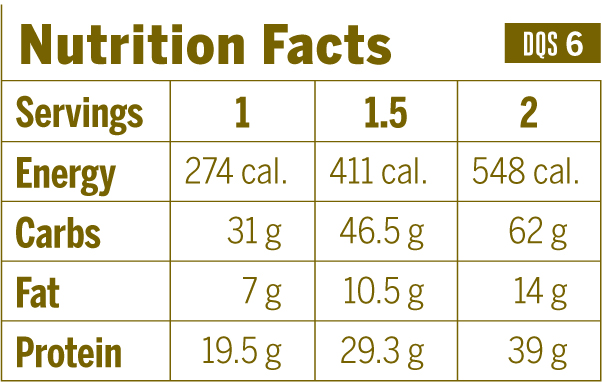
The two most important characteristics of the meals and snacks you eat during a quick start are high protein content and high quality. Eating high-protein meals and snacks will satisfy your appetite with fewer calories than would normally be needed to do the job, which will enable you to maintain your desired daily calorie deficit with less hunger. It will also help you build more muscle in conjunction with your strength training, improving your body composition directly by increasing your body’s muscle-to-fat ratio, and indirectly by increasing your resting metabolism so your body burns more fat at rest.
This chapter presents a selection of recommended meals and snacks that meet these two criteria. They are almost entirely made up of the food types designated as “high quality” in the Diet Quality Score system: fruits, vegetables, whole grains, lean proteins, low-fat dairy, and essential fats. They contain virtually no trace of any of the food types designated as low quality: sweets, processed grains, fatty proteins, and high-fat dairy foods. I do not believe in forcing oneself to eat “perfectly” all the time, but I do believe in trying (at least trying!) to eat perfectly during a quick start. This is the time to do everything possible to maximize your fat-loss results.
GETTING YOUR FILL OF PROTEIN
Most but not all of the meals and snacks presented here are high in protein. With them you can easily create a variety of one-day eating plans that hit the quick start protein target of 30 percent of total calories. The average American diet is 18 percent protein. While that’s already a high-protein diet when you consider that for most people a 10 percent protein diet is adequate to support optimal health, the typical American diet still does not provide enough protein to support a maximally effective short-term weight-loss period in endurance athletes. Research has shown that protein intake must exceed 25 percent of total calories to have a meaningful impact on satiety,1 and getting this much protein requires a careful approach.
Cutting down the amount of carbohydrate and fat you eat, to reduce your total calorie intake during your quick start, will itself increase the contribution of protein to the total calories in your diet. You can further increase protein as a percentage of total energy in your diet by slightly increasing the amount of healthy high-protein foods you eat. These include fish, nuts, soy foods (soybeans happen to be exactly 30 percent protein), and lean cuts of poultry and other meats.
Many athletes find it easiest to consistently hit the 30 percent mark when they include protein supplements such as protein shakes and bars in their diet. I recommend the shakes, and especially powdered protein shake mixes that contain very little else besides protein. These can be mixed into water, oatmeal, yogurt, smoothies, and other beverages and foods to increase your protein intake in a calorically efficient way. Protein bars tend to be rather calorie dense and contain a lot of highly processed artificial ingredients. Some athletes don’t like the idea of consuming any protein supplements, but I consider the best protein powders to be reasonably natural and very high-quality foods, and for this reason I include them in my quick start plans. You certainly don’t have to use them if you don’t want to, but they are the most calorically efficient protein source (meaning they provide the most protein per calorie), so it will be a little more difficult to hit your 30 percent protein target and your calorie deficit target simultaneously without them.
KEEPING YOUR DIET SIMPLE
Your freedom of choice in food selection does not have to be limited to the meals and snacks presented in my quick start program. You should feel free to eat literally anything you want during your quick start as long as it all adds up to a roughly 30 percent protein diet, a near-maximal DQS, and the appropriate number of calories at the end of the day. With a little planning you can easily meet these standards on any sort of diet, from vegan to gluten free. The seven breakfasts, seven snacks, seven lunches, and seven dinners presented in these chapters are just suggestions that will make your quick start easier by sparing you the trouble of counting calories and protein grams and vetting quality.
Twenty-eight total meals and snacks might not seem like a ton of variety, but it’s actually more variety than most of us have in our diets (how many different breakfasts have you had in the past week?), and a little monotony in the diet is actually not a bad thing when you’re trying to lose fat. Studies have found that people eat more when they eat a wider variety of foods, apparently because satiety results in part from tiring of the taste of food, which obviously happens faster when you’re eating just one thing.2 And a National Weight Control Registry study reported that men and women who had successfully maintained a large amount of weight loss for a long period of time had a less-varied diet than dieters who had regained lost weight.3 The authors of this study speculated that limiting the variety of foods in the diet might help people manage their total caloric intake more effectively.
The virtue of simplicity is manifest not only in the variety of quick start meals and snacks I’ve selected for you but also in their preparation requirements. All the recommended quick start meals and snacks are very easy to prepare. Complete recipes are not provided, however; only basic portion size and nutrition information. If you are a confident chef, feel free to put your own twist on preparing these meals, but be sure to do so in ways that do not add a lot of extra calories. For example, try adding different spices, fresh herbs, onion, or garlic to enhance the flavor of a meal. If you need more guidance, visit food.com and enter keywords associated with any specific meal presented here in the search box to find complete recipes that use similar ingredients. In the next chapter I will show you how to put together these meals and snacks so you can hit hit your quick start daily calorie and protein targets. The ingredients listed add up to a single serving, so if your calorie needs are higher, you’ll need to adjust those accordingly. To make your daily calorie computations a little easier, I present nutrition facts for 1, 1.5, and 2 servings for each meal or snack.
I’ve tallied the DQS for each meal and snack in order to help you become more familiar with this scoring system. Should you choose to incorporate different meals and snacks, you will want to tally your DQS to be sure you are choosing high-quality foods. You’ll notice that the DQS doesn’t vary with the number of servings. This is because the DQS takes into account individually appropriate portions. For example, a petite female runner and a tall male triathlete will eat different portions of a tuna steak, amaranth, and kale dinner, but the DQS will be the same for both athletes. Be aware that the scores of some meals and snacks may vary based on what you’ve already eaten in the day. For example, the “Tofu with Vegetable Stir-Fry and Brown Rice” dinner is valued at 8 points on its own. But two of those points come from brown rice, a whole grain, and whole grains are worth 2 points in each of the first two servings you eat in a day, but the third serving is worth only 1 point. So if you’ve already eaten two whole grains when you sit down with a plate of tofu and vegetable stir fry with brown rice, it’s worth 7 points instead of 8.
QUICK START BREAKFASTS
These seven breakfast menus include hot and cold, larger and smaller, and vegetarian and non-vegetarian options.
BAGEL WITH CREAM CHEESE & LOX
1 whole-wheat bagel
2 Tbsp. light cream cheese
2 tomato slices
2 oz. lox

BREAKFAST WRAP
1 whole-wheat tortilla (8 inches)
½ cup egg substitute*
1 cup grilled, diced green and red peppers, onions
1 oz. shredded low-fat cheddar cheese
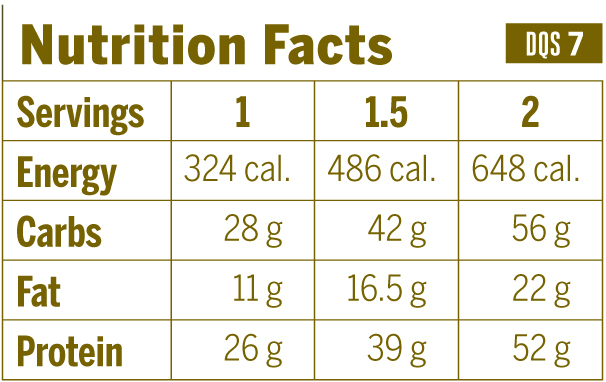
*Egg substitute is recommended instead of whole eggs because it is more protein dense and less calorie dense than whole eggs. Egg substitute is simply egg white. Feel free to use a packaged egg substitute such as Egg Beaters or use the whites of whole eggs. It’s okay to use whole eggs if you much prefer their taste and/or texture.
CEREAL WITH SKIM MILK
2 cups cereal
1 cup skim milk
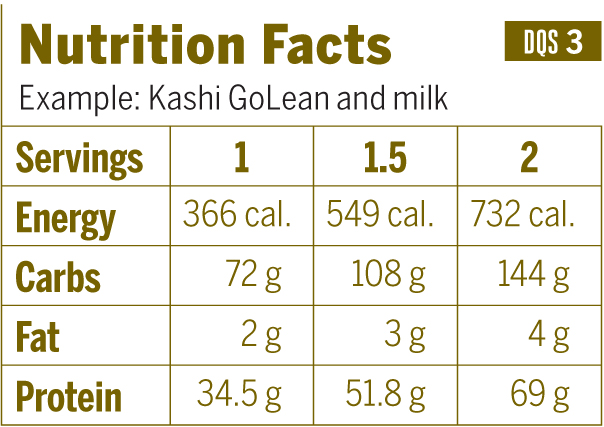
Some breakfast cereals are very wholesome, but others are candy in disguise. Below are some cereals that pass Racing Weight quick start standards. All are made with whole grains and do not list any form of sugar among their top two ingredients. Most are not particularly high in protein. Kashi GoLean is one of the few breakfast cereals that offers more than 30 percent of its calories from protein. There are, however, a few other cereals that, when combined with skim milk, make 30 percent protein meals. Some don’t reach that protein level even with milk, but it is not necessary that every single meal you eat be 30 percent protein.
Bob’s Red Mill Granola
Cheerios
Cinnamon Puffins
Ezekiel 4:9 Organic Golden Flax
Fiber One Honey Clusters
Kashi GoLean
Nature’s Path Flax Plus Flakes
Post Grape-Nuts Flakes
Post Raisin Bran
Quaker Oatmeal Squares
VEGETABLE OMELET
¾ cup egg substitute
¼ cup cooked spinach (start with 2 cups raw)
2 Tbsp. diced tomatoes
¼ cup onions

PROTEIN SMOOTHIE
1 cup low-fat yogurt
4 oz. orange juice
½ banana
1 scoop protein powder
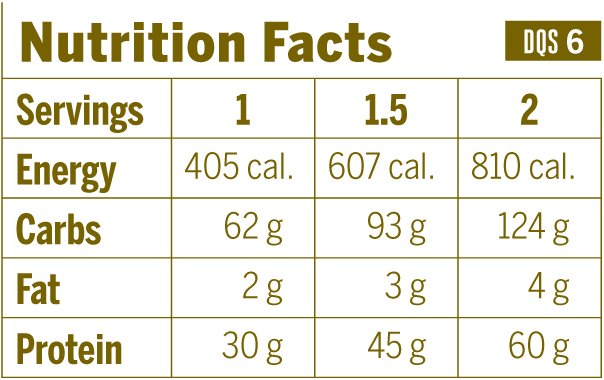
1 cup egg substitute
½ cup diced bell peppers
2 Tbsp. diced onions
¼ cup sliced mushrooms

PROTEIN TEFF PORRIDGE
1 cup teff
1 scoop protein powder
¾ cup date pieces
½ cup walnut pieces
1 Tbsp. butter
¼ cup skim milk
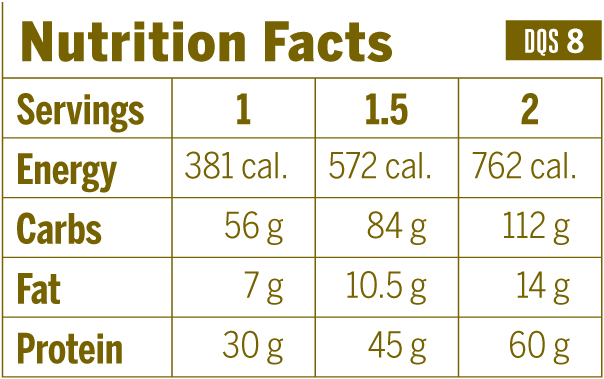
QUICK START SNACKS
You won’t find potato chips on this list of healthy snacks!
CELERY STICKS WITH PEANUT BUTTER
8 celery sticks
2 Tbsp. reduced-fat old-fashioned peanut butter
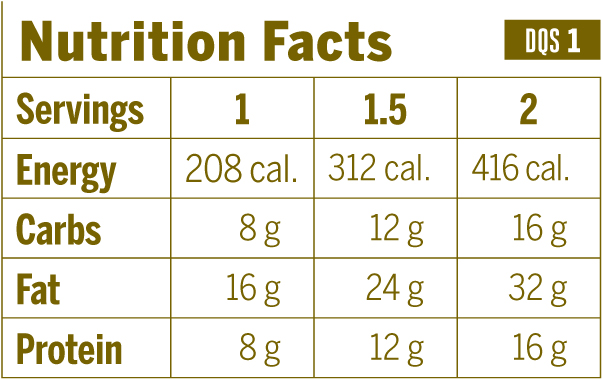

Only real-food energy bars made with fruit, whole grains, nuts, etc. and with minimal added sugar are acceptable in a Racing Weight quick start. Examples are Forze Bar, Greens+ Natural Energy Bar, Perfect Foods Bar, and PowerBar Nut Naturals Bar.
FRUIT SMOOTHIE WITH PROTEIN
8 oz. orange juice
1 fresh banana
½ cup frozen strawberries
½ cup frozen blueberries
1 scoop whey protein powder
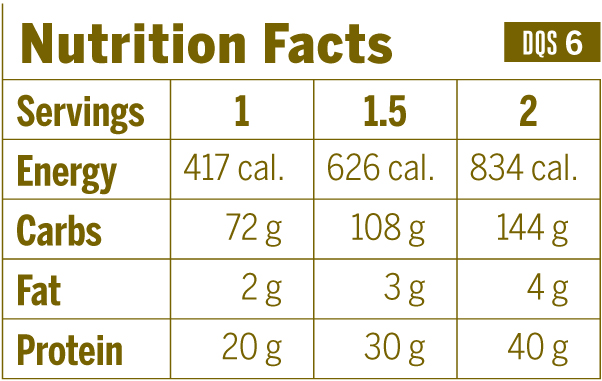
AVOIDING HIDDEN SUGAR
Almost all flavored yogurts contain added sugar. A little sugar in your yogurt won’t kill you, but it’s so unnecessary. Plain yogurt already contains lactose sugar and fruit sweetens it plenty. That’s why I recommend you buy plain yogurt and add your own fruit to sweeten it.
Almost all packaged sandwich breads also contain sugar, as with yogurt. I don’t know why, because it’s just not needed. Shop at health food stores instead of supermarkets to find the few brands of bread out there without some type of sugar on the ingredients list.
Save the added sugar for foods that really “need” it, like that little square of dark chocolate you might allow yourself after dinner!
1 oz. jerky (beef, turkey, fish, or venison)

YOGURT WITH FRUIT
1 cup plain low-fat yogurt
¼ cup fruit (peach, blueberries, etc.)
1 Tbsp. 100% fruit preserves* (peach, blueberry, etc.)
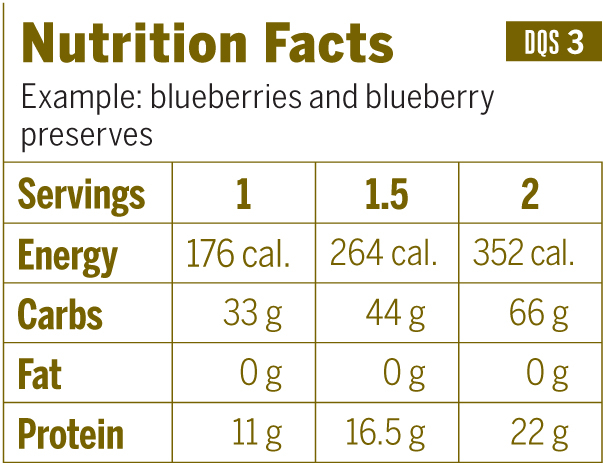
*100% fruit means fruit is the only ingredient on the label.
PROTEIN SHAKE
Pick your protein: Soy or whey. The best-quality protein shake mixes are to be found at your local natural foods market (e.g., Whole Foods). An increasing number of regular supermarkets also carry a small selection of these products.
SOY PROTEIN SHAKE
1 scoop soy protein shake mix
8 oz. skim milk
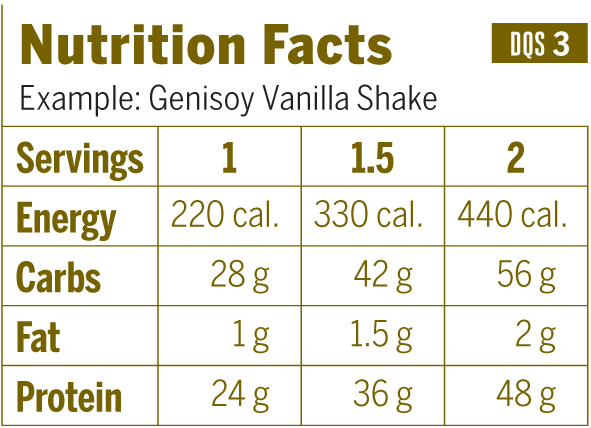
1 scoop whey protein shake powder
8 oz. water or skim milk

WHOLE FRUIT
1 whole apple, banana, orange, pear, etc.
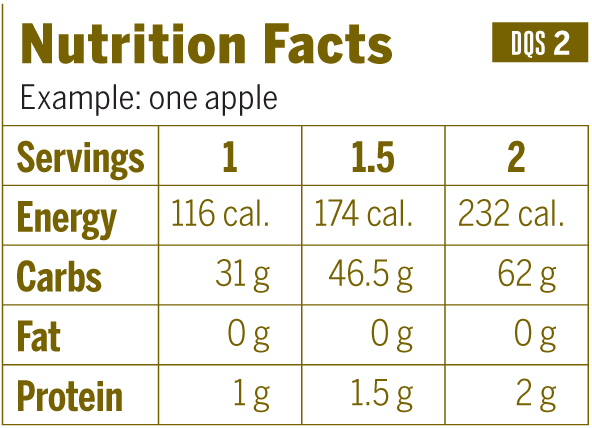
Quick: Name four whole grains. Let’s see, there’s whole wheat, brown rice, oats and . . . what else? Don’t feel bad. Even the most health-conscious eaters often stick to the same three foods as their whole-grain sources. But there are lots of other options with different tastes and nutrient profiles to give your palate and your body some welcome variety. Following are five alternative whole grains to try. Most can be found at your local natural foods market.
AMARANTH: These seeds have a creamy consistency when cooked and an earthy taste. Amaranth is among the most fiber-rich and protein-rich grains.
BUCKWHEAT: Also called kasha, buckwheat has a strong, distinctive taste and is rich in the phytonutrient rutin.
QUINOA: This grain provides one of the broadest amino acid spectrums in the plant kingdom and is appreciated for its nutty taste.
SPELT: Similar to wheat, spelt contains more protein, fiber, magnesium, selenium, and niacin than its close grain cousin. It has a chewy consistency when cooked and a light sweetness on the tongue.
TEFF: This grain cooks into a porridge-like consistency and has a slightly malty taste. It’s a great source of iron, calcium, fiber, and B vitamins, among other nutrients.
QUICK START LUNCHES
You can’t go wrong by including any of these lunch menus in your quick start.
TURKEY SANDWICH
2 slices high-protein bread (e.g., P28 bread)
3 oz. lean turkey breast
1 Tbsp. mustard
Onion, lettuce, tomato

CHICKEN, BEAN & VEGGIE BURRITO
1 whole-wheat tortilla (8 inches)
3 oz. shredded grilled chicken
¼ cup black beans
½ cup grilled red and green bell peppers, onions
3 Tbsp. avocado, pureed
2 Tbsp. salsa

CHICKEN CAESAR SALAD
2 cups romaine lettuce
2 Tbsp. low-calorie Caesar salad dressing
3 oz. chicken breast
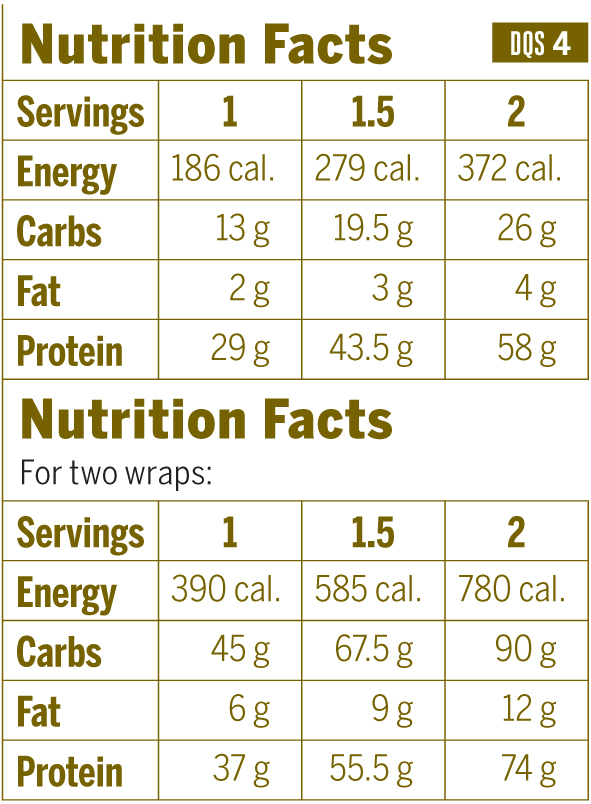
To eat as wraps, add 2 whole-wheat tortillas.
TUNA MELT
1 slice whole-wheat bread
2 oz. albacore tuna
1 Tbsp. mayonnaise
Diced onions to taste
Tomato slice
1 deli slice provolone cheese
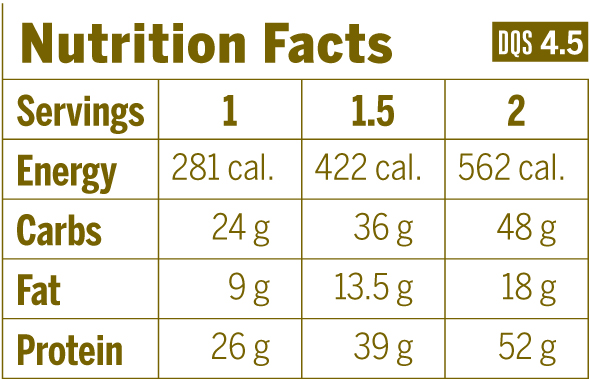
1 9-inch whole-wheat tortilla
3 oz. London broil steak strips
1 cup grilled red & green peppers, onion
2 Tbsp. reduced-fat Russian salad dressing

LENTIL & SAUSAGE SOUP
12 oz. lentil soup
2 oz. sliced lean kielbasa
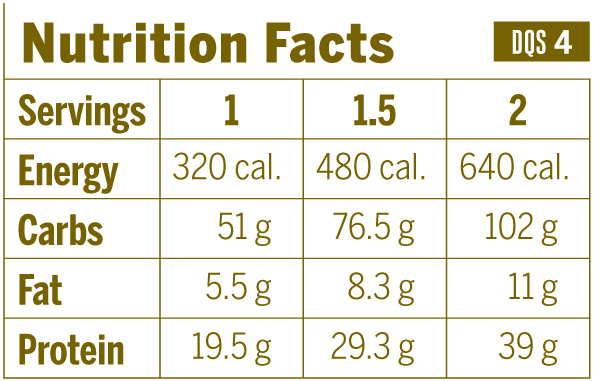
PEANUT BUTTER & JELLY SANDWICH
2 slices protein bread
2 Tbsp. old-fashioned reduced-fat peanut butter
1 Tbsp. 100% strawberry preserves
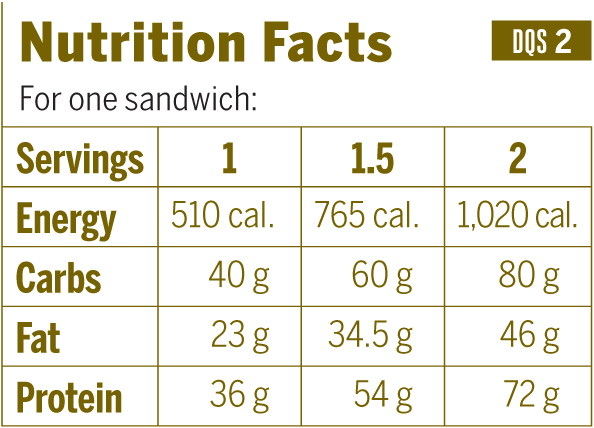
Don’t laugh—no less an endurance athlete than six-time Hawaii Ironman world champion Dave Scott eats a PB&J sandwich almost every day. Use these “grown-up” ingredients and you’ll enjoy a sandwich that is tastier and healthier than the ones you found in your school lunchbox.
If you are a vegetarian or vegan, you have probably noticed that only a fraction of the meals and snacks presented here are appropriate for you. Don’t fret. There are plenty of things you can eat for breakfast, lunch, dinner, and snacks that will collectively meet your quick start standards, including the 30 percent protein standard that is, admittedly, a little tougher for vegetarians and vegans to meet. Here are some suggestions:
For breakfast, rely on high-protein cereals such as Kashi GoLean and pour soy, hemp, rice, coconut, or almond milk over them if you are vegan, or skim cow’s milk if you consume it. Naturally, lacto-ovo vegetarians may also eat any of the egg-based breakfasts presented in this chapter, while vegans can transform any grain-based breakfast (old-fashioned oatmeal, teff porridge, buckwheat pancakes, etc.) into a high-protein repast by mixing in a plant-based protein powder.
Speaking of plant-based protein powders, if you are a vegan you will almost certainly need to rely on one or more such products daily to meet your elevated quick start protein requirement. In addition to soy protein powder, hemp, rice, and pea protein powders are available.
There is a variety of plant food products besides protein powders that can help you bootstrap your way to high-protein intake, including other soy products such as tofu, tempeh, soy yogurt, and edamame; seitan, or wheat gluten, which is used to make veggie burgers and such; and protein-fortified breads such as hemp bread.
As a vegetarian, you would do well to emphasize bean-based soups, stews, chilis, and other dishes in your quick start dinners. You are probably aware that legumes such as lentils (30 percent protein exactly) are the most protein-rich plant foods. But there are many plant foods that get a high percentage of their calories from protein even though they don’t contain large absolute amounts of protein (or calories in general). To name a few:
Asparagus |
34% |
Broccoli |
27% |
Mushrooms |
43% |
Spinach |
39% |
(Of course, mushrooms are technically a fungus, not a plant food.)
By packing your quick start diet with these foods, you can eat very normally and still meet your protein requirement. You’ll have to eat a lot of asparagus and such to get enough calories in the day, but that’s not such a bad thing, and it’s also life as a vegetarian or vegan athlete.
All seven of these dinners have the high protein content and low calorie density you’re looking for in quick start meals.
SALMON, BROWN RICE & SNOW PEAS
½ broiled salmon fillet
⅔ cup brown rice
½ cup steamed snow peas

CHICKEN & BROCCOLI STIR-FRY
⅔ cup broccoli crowns
4 oz. chicken tenders
½ cup brown rice
2 Tbsp. low-sodium soy sauce
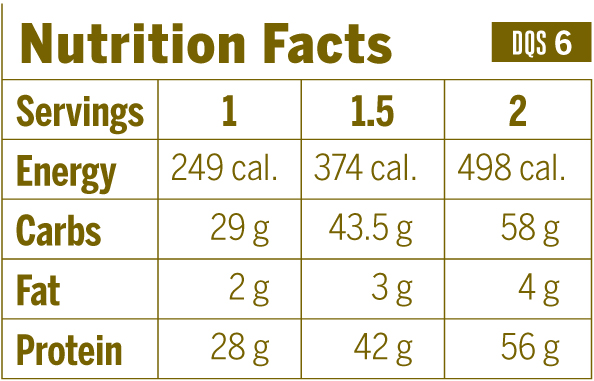
TOFU & VEGETABLE STIR-FRY
¼ cup baby corn
¼ cup sliced bell peppers
¼ cup sliced mushrooms
¼ cup cooked bok choy (use 2 cups fresh)
4 oz. tofu cubes
½ cup brown rice
2 Tbsp. low-sodium soy sauce
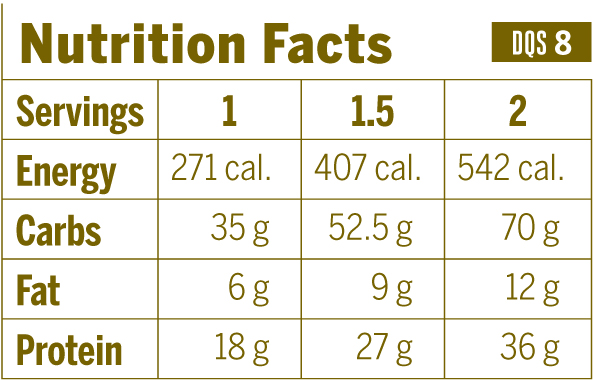
Protein is always important, but it’s especially important during a quick start, when you aim to get 30 percent of your daily calories from protein to control appetite and preserve muscle mass. Not all protein sources are equal, though. Some high-protein foods are also high-fat foods. You’ll want to avoid these for the most part during your quick start, not because you’re at any risk of eating too much fat, but because you’re trying to limit calories, and fat has more than twice as many calories per gram as protein and carbohydrate. What you want instead are low-fat, lean proteins. Here’s a list of recommended lean protein sources with protein and fat contents per serving:
Lean Protein Sources |
Protein |
Fat |
Baked beans |
12 g |
1 g |
Chicken breast |
27 g |
3 g |
Egg substitute |
15 g |
4 g |
Fish, wild caught (e.g., Atlantic cod)* |
19 g |
1 g |
Ground beef (95% lean) |
18 g |
3 g |
Lentils |
9 g |
0.5 g |
London broil |
30 g |
5 g |
Pork tenderloin |
22 g |
3 g |
Tofu |
10 g |
6 g |
Tuna, canned (water packed) |
21 g |
3 g |
Turkey breast |
24 g |
1 g |
Whey protein powder |
18 g |
2 g |
Yogurt (low fat) |
13 g |
4 g |
Note that the manner of preparing meats and fish also affects how lean they are. Baking, roasting, broiling, grilling, and roasting generally add little or no fat calories to meats and fish, while frying does.
* Protein and fat contents in fish vary by species.
TURKEY BREAST, QUINOA & BRUSSELS SPROUTS
6 oz. roasted turkey breast
½ cup quinoa
1 cup boiled Brussels sprouts

PORK TENDERLOINS, SWEET POTATO & SWISS CHARD
4 oz. roasted pork tenderloins
4 oz. roasted sweet potatoes
1 cup boiled Swiss chard

TUNA STEAK, AMARANTH & KALE
8 oz. tuna steak
¼ cup amaranth seeds
1 cup boiled kale

TURKEY MEATLOAF, BLACK BEAN & CORN SALAD
6 oz. meatloaf made with lean ground turkey
½ cup black bean and corn salad
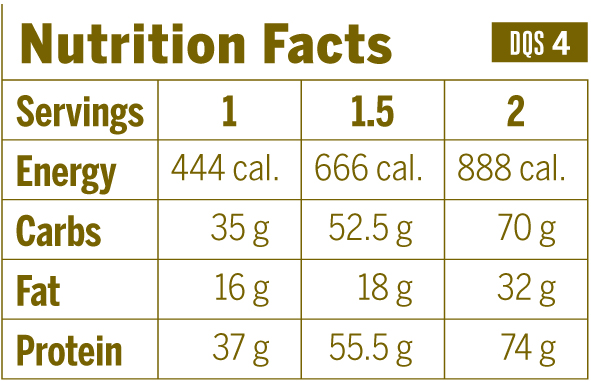
AND TO DRINK
You probably noticed that there are no beverages included in these meals. Obviously, you will want to drink something with most of your meals and snacks, as well as throughout the day, to satisfy your thirst and stay hydrated. Here are some guidelines for beverages during the Racing Weight quick start:
• Drink as much water as you want, and try to have water handy throughout the day so you are easily able to drink whenever you are thirsty.
• As much as possible, avoid beverages that subtract from your Diet Quality Score. You get one freebie each day.
• Drink as much 100 percent fruit juice as you like, but be aware that it adds a lot of calories to your diet without much of a satiating effect and is very low in protein.
• Drink up to three cups of coffee or green tea per day, if that’s your habit and you tolerate caffeine well, but sweeten it little or not at all.
For a better idea of how some drinks dilute your DQS, see Table 4.1. You will notice that all beverages containing added sugar, all beverages containing fat, and all alcoholic beverages will negatively affect your DQS. Yes, this also includes all beverages containing artificial sweeteners because these drinks are associated with weight gain even though they contain no calories.
TABLE 4.1 DQS SCORING OF DRINKS
SERVINGS |
1 |
2 |
3 |
4+ |
HIGH-QUALITY DRINKS | ||||
PROTEIN SHAKES (low fat, low carb) |
2 |
Count as lean proteins |
||
SKIM MILK |
1 |
Count as low-fat dairy |
||
SPORTS DRINKS (during exercise) |
0 |
0 |
0 |
0 |
WATER |
0 |
0 |
0 |
0 |
COFFEE & TEA (unsweetened/lightly sweetened) |
0 |
0 |
0 |
-1 |
LOW-QUALITY DRINKS | ||||
ALCOHOL (beer, wine, spirits) |
0 |
-2 |
-2 |
-2 |
COFFEE & TEA (sweetened, cappuccino, latte, chai) |
-2 |
-2 |
-2 |
-2 |
ENERGY DRINKS (Red Bull, Monster, etc.) |
-2 |
-2 |
-2 |
-2 |
PROTEIN SHAKES (high fat or high carb) |
-2 |
-2 |
-2 |
-2 |
SOFT DRINKS |
-2 |
-2 |
-2 |
-2 |
WHOLE MILK |
-2 |
-2 |
-2 |
-2 |
You should also be aware of what constitutes a serving. A bottled soft drink is likely 1.5 or 2 servings. A pint of beer is more than one serving. You get the picture.
There are countless other meals and snacks that would fit into a quick start plan, provided they meet the requirements of being high-quality foods that are also high in protein. It’s my hope that by using these options you can spend less time in the kitchen and avoid the hassle of calculating nutritional facts, leaving you more time and energy for training.
![]()
1 H. J. Leidy, M. Tang, C. L. Armstrong, C. B. Martin, and W. W. Campbell, “The Effects of Consuming Frequent, Higher Protein Meals on Appetite and Satiety during Weight Loss in Overweight/Obese Men,” Obesity (Silver Spring), September 16, 2010.
2 H. A. Raynor, R. W. Jeffrey, D. F. Tate, and R. R. Wing, “Relationship between Changes in Food Group Variety, Dietary Intake, and Weight during Obesity Treatment,” International Journal of Obesity and Related Metabolic Disorders 28, no. 6 (June 2004): 813–20.
3 H. A. Raynor, R. W. Jeffery, S. Phelan, J. O. Hill, and R. R. Wing, “Amount of Food Group Variety Consumed in the Diet and Long-Term Weight Loss Maintenance,” Obesity Research, 13 (2005): 883–90.